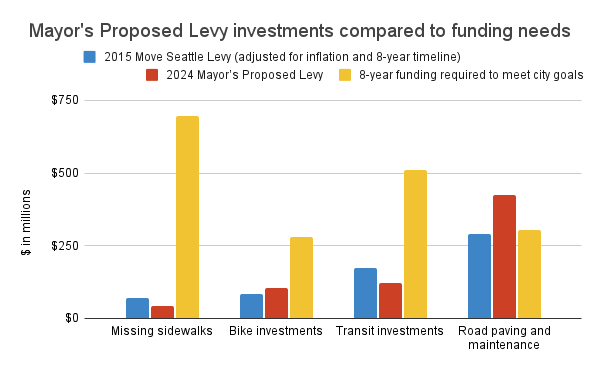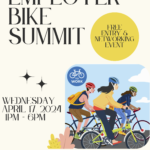The $930 million Move Seattle Levy was the most ambitious city transportation levy in the U.S. in 2015, but it also overpromised on what it could feasibly deliver for those dollars. The result is that Seattle has completed a lot of great work while also failing to meet the goals promised to voters, especially for transit but also for walking and biking.
Now, nine years later, Mayor Bruce Harrell is proposing a larger eight-year, $1.35 billion transportation levy to replace the Move Seattle Levy when it expires at the end of this year. That is a 45% increase in total, but a 63% (24% when adjusted for inflation) increase per year since the new levy will be in effect for one fewer year. Though most spending categories would see increases in the new levy, some increases outpace others, and other increases do not keep up with inflation. You can see more details and provide public feedback via the city’s online engagement website.
Seattle Neighborhood Greenways, Disability Rights Washington and a coalition of other organizations are holding an Earth Day rally 2 p.m. Saturday (April 20) at Jimi Hendrix Park calling for “more housing and better transportation” from Seattle’s transportation levy and comprehensive plan.
The 2015 and 2024 levy proposals break out their funding levels slightly differently, so it’s a bit difficult to compare them directly. I created a spreadsheet that combines categories that seem to cover similar work to get an idea of where the bulk of the increases will go. The Move Seattle Levy figures come from this spending proposal document (PDF) and the Harrell levy figures from from this summary document (PDF). My spreadsheet includes one sheet with the numbers for each as stated and another in which I attempted to combine funding pools to make it easier to compare the changes:

The most difficult issue for comparing these levies is that the Move Seattle Levy dumped a lot of different priorities into a $139 million “corridor mobility improvements” category. And frankly, this framework was a disaster. It was unclear from the start which priorities would win out or what level of improvements those corridors would receive. In the end, most of the projects in that bucket ended up either disappointing or costing way more than was allotted. The new levy has a new $121 million line item to “connect people safely to transit hubs,” which seems to be where most of the bus and transit improvements have moved. But that $121 million also includes transit access projects for walking, biking and accessibility, so it’s not clear how much of the budget will actually go to bus reliability improvements. I could not find a good way to compare transit funding between the 2015 and 2024 levy proposals. Council should seek a straightforward answer to make sure we are properly investing in very popular improvements for our buses.
In general, the way the new levy proposal talks about buses is a bit concerning. It mostly describes buses as a way to connect people to transit hubs, but buses are so much more than that. Bus routes should be improved whether they connect to a light rail station or the neighborhood grocery store. Seattle is a bus city, and the levy should embrace and celebrate that. It would be very popular if people knew their humble neighborhood routes would be getting some love from the levy. Otherwise, this could be a major issue for voters. The Council should ask SDOT to boost the bus reliability section, and they should be ready to put more funding behind it as well.
Biking route funding does get a 47% annual boost under the mayor’s proposal, but that is below the total increase rate of 63% and only a modest increase over the current rate when adjusted for inflation. The biking category would need an additional $1.5 million more per year ($12 million total) in order to grow at the same 63% as the rest of the levy.
Sidewalks, curb ramps and crosswalks are even worse off, however. When adjusted for inflation, these priorities actually see a cut of about $1.88 million per year. This figure gets even worse if you include some or all of the Northgate Bridge in the 2015 total. To grow this line to keep up with inflation, Council would need to add at least $15 million. To keep it in proportion with the rest of the levy, they would need at least $55 million. The proposed levy does increase Vision Zero funding by 70% per year, and some of these projects could also include sidewalk, curb ramp, and crosswalk improvements. But that increase does not make up for the other pedestrian improvements cuts.
Street paving, meanwhile, gets a 90% annual boost, which comes out to a stunning $25 million more per year than the current levy. Bridge maintenance also gets a large 75% annual boost, which is about $12 million more per year. The value of these two major maintenance categories relies heavily on the quality of the Seattle Transportation Plan and the prioritization process for choosing projects. Will they choose mostly car-centric streets with few upgrades for biking, walking and transit, or will they choose streets that close gaps in the bike network and improve bus times and crosswalks?
The “freight mobility” line appears to take a hit, but $20 million of the 2015 total was for the Lander Street Overpass, which was the single largest city expense in the entire 2015 levy. The 2024 levy proposal would increase the regular freight improvements budget over the 2015 levy, it just doesn’t include another new bridge in SoDo. Maintenance for vital freight bridges would be covered by the big increases to the general bridges budget.
“Urban forestry” is now part of the “Climate Change” section, but the documents do not spell out how its budget will change.
Perhaps the most questionable standout is the 276% increase for traffic signal maintenance and upgrades, which comes out to $9 million more per year. The Mercer Street so-called “Intelligent Traffic System” project has not justified increased investment into these technologies, at least not at this scale. So far, these systems have only been able to increase car throughput at the direct expense of people walking and biking, which is not a positive outcome. That said, the city has done lots of good things with regular traffic signals, such as programming walk signal head starts and installing better bike detectors and bike-specific signals. So I’m not saying city leaders should zero out this line or anything, but much of this $9 million per year increase could go to other needs like bringing the biking, walking and transit budgets closer to parity with other categories.
But no matter how you move these numbers around, this levy proposal does not represent a moonshot to address our city’s traffic safety crisis. This will be on a very high-turnout ballot, and voters would go for a more ambitious levy if given the chance. In fact, my biggest worry is that folks will be less motivated by something that does not include meaningful increases to sidewalk and transit funding, which are top-level requests every time Seattleites are asked for their transportation opinions. This measure is going to face all the usual anti-tax opposition, so it will need dedicated volunteers on the ground making calls and knocking on doors in order to overcome the naysayers. Is this good enough to inspire those volunteers?
Seattle Neighborhood Greenways and Disability Rights Washington have been out in front pushing back against cuts to pedestrian and transit spending in the proposed levy. By their analysis, pedestrian funding would be cut by $32 million and transit by $52 million once the figures are adjusted for inflation. Meanwhile, “car-focused spending” would increase $189 million, the groups say. Here’s a chart they put together:

Here are the changes they are seeking:
Our Demands:
- Dedicate at least 50% of levy funding to improvements for people walking, rolling, biking, and riding transit (a minimum!)
- Prioritize levy funding for historically disinvested communities that do not yet have safe walking and biking infrastructure.
- Propose a larger levy total of at least $1.7B.
Specifically, we’re pushing for funding for:
- Accessibility — sidewalks and crosswalks: Dramatically increase the funding to build sidewalks. The Mayor’s proposal will support building just 250 blocks of sidewalks – only 2% of the city blocks where they are currently missing. At this rate, people with disabilities will have to wait over 400 years to move safely and freely in our city.
- Safety — Vision Zero: Add funding to cover safety redesigns on the 5 most dangerous streets in Seattle: Aurora Ave N, MLK Way S, 4th Ave S, Rainier Ave S, and Lake City Way.
- Transit Reliability: Reverse cuts to the transit program to ensure buses are efficient and reliable.
- Equitable Bike Routes: Add funding to maintain bike programs, adjusted for construction cost inflation. Prioritize bike projects to complete a connected bike network through South Seattle, including a convenient direct arterial route north-south through the Rainier Valley.
- Anti-Displacement Work: Add funding for community-led planning and land acquisition to prepare for light rail expansion in Graham Street and C/ID to help communities remain rooted in place.
- Urban Freeway Mitigation: Add funding to mitigate the environmental, social, and economic impacts impact highways have on our communities.
- Livability: Add funding for accessible public restrooms for transit hubs, light rail stations, and public gathering spaces to make our transportation system accessible for families, elders, unhoused people, and more.
Cascade Bicycle Club, meanwhile, has a less ambitious ask. They are seeking an additional $20 million for bike route improvements especially near schools and in South Seattle.
At a bare minimum, the Council should add enough funding for walking, accessibility and transit so that that funding keeps up with inflation otherwise the talking point that this levy will cut sidewalk and transit spending could do real harm to the campaign.
But really, Council should increase walking, biking, accessibility and transit funding enough to actually achieve our safety and transit ridership goals. We’ve done a lot of good things in the past nine years, but we still are not making improvements fast enough. Our city committed to eliminating serious injuries and deaths on our streets by 2030. Let’s send voters a levy that has a fighting chance of getting us there.










Leave a Reply